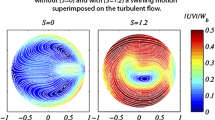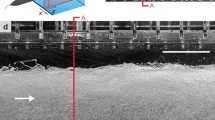Abstract
A key feature of breaking bores, jumps, and spilling breakers is the roller region, characterised by intense shear and recirculation, associated with air bubble entrainment and splashing. Detailed unsteady air–water flow measurements were conducted in a breaking bore propagating in a large-size channel, using an array of dual-tip phase-detection probes and an ultra-high-speed video camera. The results showed a steep roller front, with a very-dynamic air–water bubbly region, albeit with a relatively limited air–water roller region. In this study, a major challenge was the inconsistency in light intensity linked to the travelling nature of the bore. A simple flow visualisation technique was applied to retrieve the two-dimensional side-looking profile of the roller edge and average void fraction. The results were validated independently with a phase-detection probe. While the probe data lacked spatial variability, the study reinforces the needs of high-quality validation data set, including in unsteady transient flows.









Similar content being viewed by others
References
Bradshaw P (1971) An introduction to turbulence and its measurement. In: The Commonwealth and International Library of Science and technology Engineering and Liberal Studies. Thermodynamics and Fluid Mechanics Division. Pergamon Press, Oxford, p 218
Brocchini M, Peregrine DH (2001) The dynamics of strong turbulence at free surfaces. Part 2. Free-surface boundary conditions. J Fluid Mech 449:255–290
Cartellier A, Achard JL (1991) Local phase detection probes in fluid/fluid two-phase flows. Rev Sci Instrum 62(2):279–303
Chachereau Y, Chanson H (2011) Bubbly flow measurements in hydraulic jumps with small inflow froude numbers. Int J Multiph Flow 37(6):555–564. https://doi.org/10.1016/j.ijmultiphaseflow.2011.03.012
Chanson H (1997) Air bubble entrainment in free-surface turbulent shear flows. Academic Press, London, p 401
Chanson H (2002) Air–water flow measurements with intrusive phase-detection probes. Can we improve their interpretation?. J Hydraul Eng ASCE 128(3):252–255. https://doi.org/10.1061/(ASCE)0733-9429(2002)128:3(252)
Chanson H (2004) Unsteady air–water flow measurements in sudden open channel flows. Exp Fluids 37(6):899–909. https://doi.org/10.1007/s00348-004-0882-3
Chanson H (2005) Air–water and momentum exchanges in unsteady surging waters: an experimental study. Exp Thermal Fluid Sci 30(1):37–47. https://doi.org/10.1016/j.expthermflusci.2005.03.017
Chanson H (2013) Hydraulics of aerated flows: qui pro quo?. J Hydraul Res 51(3):223–243. https://doi.org/10.1080/00221686.2013.795917
Chanson H (2016) Phase-detection measurements in free-surface turbulent shear flows. J Geophys Eng 13(2):S74–S87. https://doi.org/10.1088/1742-2132/13/2/S74
Chanson H, Brattberg T (2000) Experimental study of the air–water shear flow in a hydraulic jump. Int J Multiph Flow 26(4):583–607. https://doi.org/10.1016/S0301-9322(99)00016-6
Chanson H, Docherty NJ (2012) Turbulent velocity measurements in open channel bores. Eur J Mech B Fluids 32:52–58. https://doi.org/10.1016/j.euromechflu.2011.10.001
Chanson H, Aoki S, Hoque A (2006) Bubble entrainment and dispersion in plunging jet flows: freshwater versus seawater. J Coast Res 22(3):664–677. https://doi.org/10.2112/03-0112.1
Coakley DB, Haldeman PM, Morgan DG, Nicolas KR, Penndorf DR, Wetzel LB, Weller CS (2001) Electromagnetic scattering from large steady breaking waves. Exp Fluids 30(5):479–487
Cointe R, Tulin MP (1994) A theory of steady breakers. J Fluid Mech 276:1–20
Cox DT, Shin S (2003) Laboratory measurements of void fraction and turbulence in the bore region of surf zone waves. J Eng Mech ASCE 129(10):1197–1205
Duncan JH (1981) An experimental investigation of breaking waves produced by a towed hydrofoil. Proc R Soc Lond A 377:331–348
Felder S, Chanson H (2014) Air–water flows and free-surface profiles on a non-uniform stepped chute. J Hydraul Res IAHR 52(2):253–263. https://doi.org/10.1080/00221686.2013.841780
Felder S, Chanson H (2015) Phase-detection probe measurements in high-velocity free-surface flows including a discussion of key sampling parameters. Exp Thermal Fluid Sci 61:66–78. https://doi.org/10.1016/j.expthermflusci.2014.10.009
Herringe RA, Davis MR (1974) Detection of instantaneous phase changes in gas–liquid mixtures. J Phys E Sci Instrum 7:807–812
Hoque A, Aoki S (2005) Distributions of void fraction under breaking waves in the surf zone. Ocean Eng 32(14–15):829–1840
Hornung HG, Willert C, Turner S (1995) The flow field downstream of a hydraulic jump. J Fluid Mech 287:299–316
Hoyt JW, Sellin RHJ (1989) Hydraulic jump as ‘mixing layer’. J Hydraul Eng ASCE 115(12):1607–1614
Hwung HH, Chyan JM, Chung YC (1992) Energy dissipation and air bubbles mixing inside surf zone. In: Proceedings of 23rd international conference on coastal engineering, Venice ASCE, Italy, vol 1, Chap 22, pp 308–321
Jones OC, Delhaye JM (1976) Transient and statistical measurement techniques for two-phase flows: a critical review. Int J Multiph Flow 3:89–116
Kimmoun O, Branger H (2007) A particle image velocimetry investigation on laboratory surf-zone breaking waves over a sloping beach. J Fluid Mech 588:353–397
Leandro J, Carvalho R, Chachereau Y, Chanson H (2012) Estimating void fraction in a hydraulic jump by measurements of pixel intensity. Exp Fluids 52(5):1307–1318. https://doi.org/10.1007/s00348-011-1257-1
Leng X (2018) Study of turbulence: the unsteady propagation of bores and surges. Ph.D. Thesis, School of Civil Engineering, The University of Queensland, Brisbane, Australia, p 364, 2 Digital Appendices. https://doi.org/10.14264/uql.2018.501
Leng X, Chanson H (2015a) Turbulent advances of a breaking bore: preliminary physical experiments. Exp Thermal Fluid Sci 62:70–77. https://doi.org/10.1016/j.expthermflusci.2014.12.002
Leng X, Chanson H (2015b) Unsteady turbulence in expansion waves in rivers and estuaries: an experimental study. Environ Fluid Mech 15(5):905–922. https://doi.org/10.1007/s10652-014-9385-9
Leng X, Chanson H (2017) Unsteady velocity profiling in bores and positive surges. Flow Meas Instrum 54:136–145. https://doi.org/10.1016/j.flowmeasinst.2017.01.004
Leng X, Chanson H (2018) Two-phase flow characteristics of a breaking tidal bore roller: microscopic properties. Hydraulic Model Report No. CH109/18, School of Civil Engineering, The University of Queensland, Brisbane, Australia, p 190 (ISBN 978-1-74272-195-8)
Leppinen DM, Dalziel SB (2001) A light attenuation technique for void fraction measurement of microbubbles. Exp Fluids 30:214–220
Liu TJ, Bankoff SG (1993) Structure of air–water bubbly flow in a vertical pipe—II. Void fraction, bubble velocity and bubble size distribution. Intl J Heat Mass Transfer 36(4):1061–1072
Lubin P, Chanson H (2017) Are breaking waves, bores, surges and jumps the same flow?. Environ Fluid Mech 17(1):47–77. https://doi.org/10.1007/s10652-016-9475-y
Misra SK, Thomas M, Kambhamettu C, Kirby JT, Veron F, Brocchini M (2006) Estimation of complex air–water interfaces from particle image velocimetry images. Exp Fluids 40:764–775
Mossa M, Tolve U (1998) Flow visualization in bubbly two-phase hydraulic jump. J Fluids Eng 120:160–165
Murai Y, Oishi Y, Takeda Y, Yamamoto F (2006) Turbulent shear stress profiles in a bubbly channel flow assessed by particle tracking velocimetry. Exp Fluids 41:343–352
Piquet J (1999) Turbulent flows. Models and physics. Springer, Berlin, p 761
Rajaratnam N (1962) An experimental study of air entrainment characteristics of the hydraulic jump. J Inst Eng India 42(7):247–273
Schlichting H, Gersten K (2000) Boundary layer theory, 8th edn. Springer, Berlin, p 707
Shamoun B, Beshbeeshy M, Bonazza R (1999) Light extinction technique for void fraction measurements in bubbly flow. Exp Fluids 26:16–26
Spiegel MR (1972) Theory and problems of statistics. McGraw-Hill Inc., New York
Stutz B, Reboud JL (1997) Experiments in unsteady cavitation. Exp Fluids 22:191–198
Stutz B, Reboud JL (2000) Measurements within unsteady cavitation. Exp Fluids 29:545–552
Toombes L (2002) Experimental study of air–water flow properties on low-gradient stepped cascades. Ph.D. Thesis, Department of Civil Engineering, The University of Queensland, Brisbane, Australia
Tricker RAR (1965) Bores, breakers, waves and wakes. American Elsevier Publ. Co., New York
Wang H, Chanson H (2015) Experimental study of turbulent fluctuations in hydraulic jumps. J Hydraul Eng ASCE 141(7):10. https://doi.org/10.1061/(ASCE)HY.1943-7900.0001010 (Paper 04015010)
Wang H, Leng X, Chanson H (2017) Bores and hydraulic jumps. Environmental and geophysical applications. Engineering and computational mechanics, Proceedings of the Institution of Civil Engineers, UK, vol 170, no. EM1, pp 25–42. https://doi.org/10.1680/jencm.16.00025
Wood IR (1984) Air entrainment in high speed flows. In: Proceedings of international symposium on scale effects in modelling hydraulic structures, IAHR, Esslingen, Germany, H. KOBUS editor, paper 4.1, p 7
Wood IR (1985) Air water flows. In: Proceedings of 21st IAHR congress, Melbourne, Australia, Keynote address, pp 18–29
Wood IR (1991) Air entrainment in free-surface flows. In: IAHR hydraulic structures design manual No. 4. Hydraulic Design Considerations, Balkema Publ., Rotterdam, p 149
Zhang G, Chanson H (2018) Application of local optical flow methods to high-velocity free-surface flows: validation and application to stepped chutes. Exp Thermal Fluid Sci 90:186–199. https://doi.org/10.1016/j.expthermflusci.2017.09.010
Acknowledgements
The authors would like to thank Dr Hubert Branger (IRPHE, University of Marseille, France) and Dr Jorge Leandro (Technical University of Munich, Germany) for their detailed review of the report and valuable comments. They acknowledge the helpful inputs of Professor Pierre Lubin (University of Bordeaux, France) and Dr Hang Wang (The University of Queensland, Australia), as well as discussions with Dr Gangfu Zhang (The University of Queensland, Australia) and Dr Matthias Kramer (The University of Queensland, Australia). The authors thank the reviewers for their helpful and constructive comment. The technical assistance of Jason Van Der Gevel and Stewart Matthews (The University of Queensland, Australia) is greatly appreciated.
Author information
Authors and Affiliations
Corresponding author
Additional information
Publisher’s Note
Springer Nature remains neutral with regard to jurisdictional claims in published maps and institutional affiliations.
Electronic supplementary material
Below is the link to the electronic supplementary material.
Appendices
Appendix 1: Video movies
Two high-speed video movies are provided as supplementary materials. Their details and characteristics are summarised below.
Finame | Description | Native movie format | Video movie details |
|---|---|---|---|
bore_probe_test8.avi | Three-quarter view of advancing bore passing the phase-detection probe array about the channel centreline | 20,000 fps. Full HD (1280 × 800 pixels) | Frame rate: 200 fps replayed at 5 fps. Full HD movie (1280 × 800 pixels). Duration: 14 s |
bore-side.avi | Side view of advancing bore | 22,607 fps. Full HD (1280 × 800 pixels) | Frame rate: 226 fps replayed at 30 fps. Full HD movie (1280 × 800 pixels). Duration: 15 s |
Appendix 2: Relationship between pixel intensity and void fraction in a breaking bore roller
In a disperse bubbly flow, a relationship between pixel intensity and bubble density may be derived from Lambert’s law on light transmission intensity (Shamoun et al. 1999):
where pio is a reference pixel intensity, Nab is the cumulative number of detected bubbles, and t is the time. ∂Nab/∂t is implicitly an instantaneous bubble count rate. The above expression for the transmittance may be re-arranged in terms of the void fraction for disperse spherical bubbles:
with C the void fraction and K a constant. Equation (10) was successfully validated for low void fractions, i.e., typically well below 0.20, against gas hold up data in water column and void fraction data beneath breaking wave (Shamoun et al. 1999; Leppinen and Dalziel 2001; Kimmoun and Branger 2007). For completeness, optical flow methods applied to free-surface air–water flows showed recently that the bubble count rate was correlated negatively to luminance standard deviation (Zhang and Chanson 2018).
In the present study, the void fraction was estimated as a linear function of the pixel intensity, following Mossa and Tolve (1998) and Leandro et al. (2012). Both studies were conducted in free-surface flows, with complete vertical distributions of void fractions ranging from close to zero up to unity, above the free-surface of a hydraulic jump roller. For the present experiments, the relationship between pixel intensity and void fraction was checked, using the data presented in Fig. 5a. The results are presented in Fig. 9. Despite the data scatter, linked to the small number of phase-detection probe measurements (six locations) and limited number of repetitions (5), the results showed a monotonic increase in pixel intensity with increasing void fraction from zero to unity. In Fig. 9, the data were correlated to a linear fit with a normalised correlation coefficient of 0.75 and a standard error of 54.1.
Rights and permissions
About this article
Cite this article
Leng, X., Chanson, H. Two-phase flow measurements of an unsteady breaking bore. Exp Fluids 60, 42 (2019). https://doi.org/10.1007/s00348-019-2689-2
Received:
Revised:
Accepted:
Published:
DOI: https://doi.org/10.1007/s00348-019-2689-2




